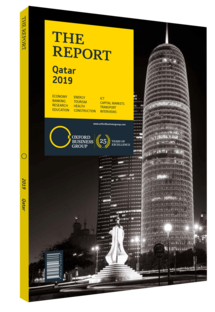Diversification leads to strong growth in non-oil and gas sectors in Qatar
Offsetting fluctuations in hydrocarbons output and prices, the non-energy sector accelerated in 2018, growing by 6% in the first half of the year, according to an IMF report released in November 2018. Real GDP growth of 2.4% was projected for 2018, up from the 1.6% growth of 2017. This expansion is set to gather momentum again in 2019, with real GDP expected to rise by 3.1% on the back of both increased hydrocarbons and non-hydrocarbons activity, before stabilising to around 2.7% per annum between 2020 and 2023. This translated into a return to fiscal balance, with the Qatar Central Bank (QCB) announcing in December 2018 that the country achieved a budget surplus of QR7.1bn ($2bn) in the first half of 2018, reversing the QR35.4bn ($9.7bn) deficit of 2017.
QCB also reported that foreign currency reserves had rebounded from the sharp outflow that followed the imposition of the regional blockade in mid-2017, which saw a 20% drop in Qatar’s foreign currency liquidity. The country’s international reserves totalled QR46.5bn ($12.8bn) in September 2018, exceeding the QR45.7bn ($12.6bn) held in May 2017 prior to the blockade. Inflation remained largely flat throughout 2018, with the Planning and Statistics Authority reporting a year-onyear (y-o-y) decrease of 0.25% in October. This drop was largely driven by falls in the price of communications, housing and utilities, and food and beverages, along with improved supply flows following the disruptions brought upon by the blockade.
Gas Focused
One of the most significant developments for the country came in the last month of 2018. In December Saad Al Kaabi, minister of state for energy affairs, announced that Qatar would leave the Organisation of the Petroleum Exporting Countries (OPEC) as of January 1, 2019. Exiting the association frees the country from OPEC-imposed restrictions on oil pricing and output ceilings. Qatar was OPEC’s 11th-largest oil producer, accounting for 2% of the club’s total output. However, the country’s oil production has declined steadily in recent years, down from 728,000 barrels per day in 2013 to 607,000 in 2017. Meanwhile, Qatar plans to solidify its status as the world’s leading exporter of liquefied natural gas (LNG). An expansion project in the North Field will add four liquefaction trains, raising LNG production from its current level of 77m tonnes a year to 110m tonnes by 2024. This 43% increase, along with a planned boost to oil production, should extend Qatar’s standing in international markets.
Banking on Stability
The banking sector has stabilised, having rebounded from the withdrawal of foreign funding from the market in the wake of the diplomatic rift with neighbouring states. Stronger energy prices in much of 2018, combined with the return of foreign liabilities, also enhanced liquidity and supported private sector credit growth, according to the IMF. This was underscored by a 1.5% y-o-y increase in bank deposits in October 2018 and credit growth of 2.7% over the same period, according to data published by Qatar National Bank. Banks also saw a solid 5% rise in asset values over the 12 months to the end of October 2018.
Free Zones
The country is looking to build on the progress made in 2018 by implementing a series of reforms and projects aimed at further diversifying the economy and facilitating overseas investment. Central to this policy is the new foreign direct investment law, which was issued in January 2019. Law No. 1 of 2019 enables 100% foreign ownership in most of the sectors throughout the Qatari economy. The new law puts foreign companies on the same legal footing as domestic firms, allowing them to bid on government contracts, while strengthening investors rights and the legal standing of companies based overseas. These changes dovetail with establishment of the Qatar Free Zones Authority in 2018, the body charged with overseeing the regulatory framework of free zones in Qatar. Two areas currently in development are located close to key logistics centres near Doha: the 30.3-sq-km Um Alhoul free zone and 3.96-sq-km Ras Bufontas free zone.
You have reached the limit of premium articles you can view for free.
Choose from the options below to purchase print or digital editions of our Reports. You can also purchase a website subscription giving you unlimited access to all of our Reports online for 12 months.
If you have already purchased this Report or have a website subscription, please login to continue.

